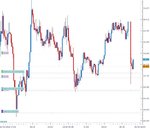Commodities rally over for now?
The commodities rally appears to be taking a pause, which has seen equity markets pull back as the outperforming materials and energy sectors now begin to drag on indices.
The FTSE materials space saw a sharp selloff overnight as it lost 3.5%, while the two big Aussie miners, BHP and RIO, lost 4.7% and 4.6%, respectively.Iron ore dropped another 0.3% overnight, but still has not fully retraced its huge 8.8% gain last Wednesday. Of course, investors are now more aware of the retail investor boom in Chinese commodity futures, which has been creating more noise than signal in prices. This could see more clear-eyed and critical pricing of the materials space, irrespective of where futures contracts are moving.
There is not a tonne of market moving data releases in Asia today, except for Hong Kong’s trade figures, which are useful for comparing against China’s inflated trade numbers. The ASX is expected to come back from the ANZAC Day national holiday to open a few points lower. The big concern will be how the materials and energy space open given the widespread slide in commodities overnight. The Nikkei is set to open higher as speculation about Bank of Japan action this week has seen a dramatic weakening of the yen.
Aussie investors will be keenly focussed on Australia’s 1Q CPI release on Wednesday, where the market consensus is expecting it to stay at 1.7%, despite the TD-MI monthly gauge averaging 2% over the quarter. Although the big rally in the Aussie dollar will have largely nixed any improved inflation momentum in 2Q as tradables inflation has dropped off dramatically.
But global investors are still holding their breath for Thursday (in Asia), which will see the Fed announcement in the early hours of the morning, followed soon after by the RBNZ and then the BOJ later in the day. The Fed is unlikely to signal June as a potential rate hike meeting, but September is likely to see its market pricing firm alongside inflation expectations. US 5-year 5-year Forward Breakeven inflation expectations have risen above 1.8% for the first time since early January.
The RBNZ look set to leave rates on hold at this week’s meeting as they wait for a few more data releases to gauge the effect of the last rate cut. It’s likely that another cut will be needed in June, and then a final cut in the second half of the year at some point. The BOJ are likely to expand their ETF purchase program on Thursday, but a further expansion of their bond purchases or cutting rates into deeper negative territory seem less likely.
Overnight data saw US New Home Sales continue to fall in March. The momentum that has been coming out of the US housing market is certainly concerning, particularly for Aussie listings such as James Hardie (JHX).


